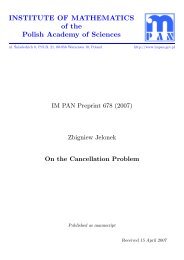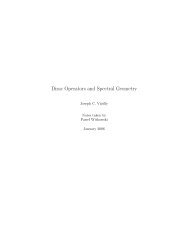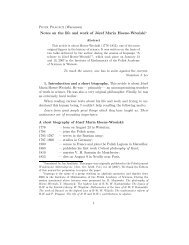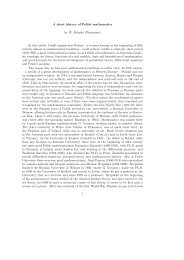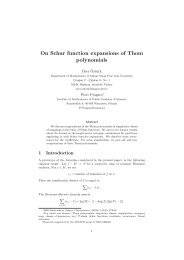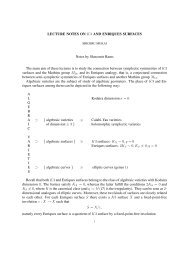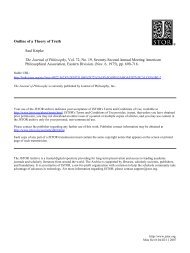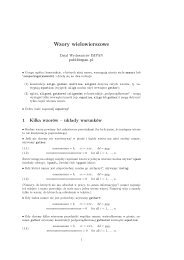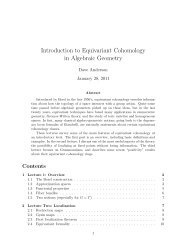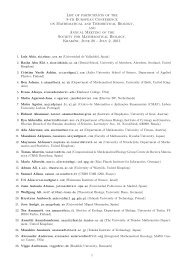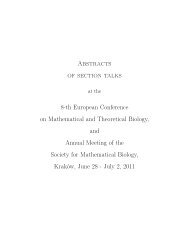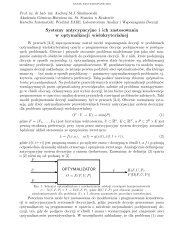About Regularization in Hilbert Space
About Regularization in Hilbert Space
About Regularization in Hilbert Space
You also want an ePaper? Increase the reach of your titles
YUMPU automatically turns print PDFs into web optimized ePapers that Google loves.
E(Ω1 ∩ Ω2), E(∅) = 0, E(R) = I. Moreover E(Ω)A = AE(Ω), and the operator A and<br />
any Borel measureable function f of this opeator may be expressed as<br />
<br />
A =<br />
<br />
tdE, f(A) =<br />
f(t)dE.<br />
if ess sup |f| = sup t≥0{t : E({x : |f(x)| ≥ t}) = 0} is bounded, then this quantity equals<br />
f(A), if it is unbounded the operator f(A) is unbounded.<br />
With the representation of A as the direct sum of operatores we can write<br />
E(Ω)x = U ∗ ⊕α χ(Ω)xαU,<br />
where χ(Ω) is the charecteristic function of the set Ω.<br />
Note also that σ(A) = supp E = <br />
α supp µα<br />
While <strong>in</strong>vestigat<strong>in</strong>g the proofs of the result of the paper, we can see that the most<br />
essentiall parts are those which refer to properties of a selfadjo<strong>in</strong>t operator. We shall give<br />
the proofs <strong>in</strong> the case when H = L2 (µ), and A is def<strong>in</strong>ed by Ax(t) = tx(t). We shall refer<br />
to this case as the model case. For some results we will present also a proof <strong>in</strong> the general<br />
case. All the others may be modified similarily.<br />
We shall use result number<strong>in</strong>g as <strong>in</strong> the orig<strong>in</strong>al paper, chang<strong>in</strong>g sometimes notations.<br />
Index function def<strong>in</strong>ition A positive function ψ : (0, ∞) → (0, ∞) is an <strong>in</strong>dex function<br />
if it is <strong>in</strong>creas<strong>in</strong>g (non-decreas<strong>in</strong>g) and cont<strong>in</strong>uous with limt→0 ψ(t) = 0.<br />
Theorem 1. Let A be a nonnegative selfadjo<strong>in</strong>t operator act<strong>in</strong>g <strong>in</strong> H with kerA = {0}.<br />
then<br />
(a) For every x ∈ H and ε > 0 there exists a bounded <strong>in</strong>dex function ψ such that the<br />
general source condition<br />
x = ψ(A)w with w ∈ H and w ≤ (1 + ε)x<br />
is satisfied, and hence x ∈ ranψ(A).<br />
(b) If x ∈ ranψ(A) for some unbounded <strong>in</strong>dex function ψ, then x ∈ ranψ0(A) for every<br />
bounded <strong>in</strong>dex function ψ0 which co<strong>in</strong>cides with ψ on (0, t0] for some t0 > 0.<br />
Comment 1. Why there is w ≤ (1 + ε)x above? – substitut<strong>in</strong>g ψ with ψε = 1+ε<br />
ε ψε<br />
and w by wε = ε<br />
1+εw we get estimation w ≤ εx, while theorem suggests that the<br />
constant 1 and any smaller one cannot be achived. However I suppose thay have some<br />
good reason for it, for example the family of <strong>in</strong>dex function ψγ(t) = γψ(t) γ > 0 should<br />
be represented by this one, that ψγ(¯α) = 1.<br />
Proof of Th. 1 part (a) – model case version We assume H = L2 (µ), Ax(t) = tx(t)<br />
and x = 1. We have x 2 = ∞<br />
0 |x(t)| 2 dµ = 1, therefore for any α ∈ (0, 1) there exists<br />
decreas<strong>in</strong>g and converg<strong>in</strong>g to 0 sequence of numbers {τn} ∞ n=0 such that<br />
<br />
|x(t)|<br />
(0,τn)<br />
2 dµ ≤ εα n , for n = 0, 1, . . . .<br />
4



